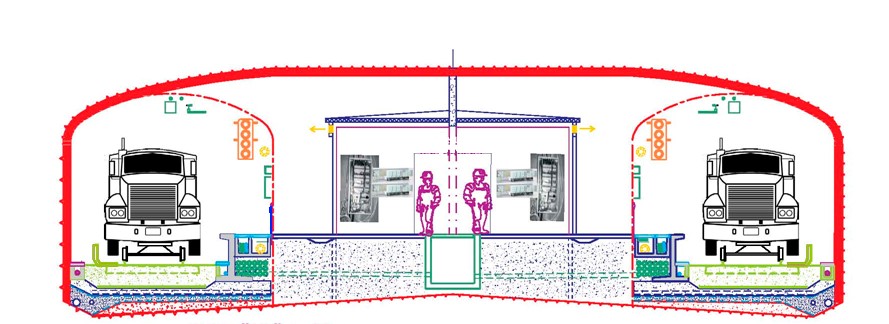A tunnel is built in multiple phases from installing building service cables to ballasting the track and installing the conductor rail. The construction process is pictured phase by phase below.
 1. Tunnel excavation is finished
1. Tunnel excavation is finished
The result of excavation is a tunnel ready for construction work. The tunnel floor is levelled and rough gravel is placed on the bottom. The rock is reinforced with bolting and shotcrete.
A drainage or drying system is installed between the rock and the shotcrete surface. Water accumulating between the rock and the shotcrete surface is directed safely via pump houses to the storm drains above ground.
 2. Bearing courses and concrete structures are built into the tunnel
2. Bearing courses and concrete structures are built into the tunnel
On top of the existing layer of crushed stone, a so-called drained layer is built from ballast. This contains a drainage sewer, underdrains and wells at 50 m intervals to conduct water.
A foundation and walls are built into the connecting tunnel between the two metrotunnels.
 3. Cable routings are built inside the exit level
3. Cable routings are built inside the exit level
A so-called supporting wall element is built between the rail and rock wall. In the completed metro, it will also serve as a 120 cm-wide exit platform. The supporting wall element conceals a large amount of technology. Inside the cables’ protective conduits, building service cables run along the entire line. Finally, the supporting wall element around the cables is filled with crushed rock.
Between the rails, cables are led technical rooms. There are two technical rooms in each connecting tunnel and 4 to 6 rooms in the shafts. Concrete walls are built in the connecting tunnels.

4. Building cable troughs and connecting tunnel structures
Cable troughs are installed on top of the cables’ protective conduits and behind the supporting wall before installation of the final covers. They contain firewater and potential additional cables.
A handrail is built along the rock wall. Lighting, camera stands and loudspeakers are attached to it. The handrail facilitates exiting during emergencies, as the rock wall in itself is uneven.
A concrete floor is built between the exit level and the connection tunnel. Concrete is a cost-effective material that doesn’t cause a fire load or create dust accumulation. A concrete surface is also comfortable to walk on in exiting situations.
Concrete walls and suspended steel ceilings are built in the technical rooms of the connecting tunnel. Their purpose is to protect sensitive technical equipment. Two doors opening inwards and one opening outwards are always built from a connection tunnel to a metrotunnel. This way, it will always be possible to exit into the adjacent tunnel despite a pressure difference between the tunnels. The connecting tunnel also has an emergency phone linked to Metropolitan Area Transport Ltd’s metro control room in Herttoniemi.
 5. Electrical and HVAC work starts
5. Electrical and HVAC work starts
To start electrical work, cables are installed in previously built protective conduits. The tunnel is also fitted with lighting comprising mainly fluorescent lamps. These are repeated in the tunnel at intervals of a few metres. Emergency exit lighting is secured in the event of power failure.
Exit signs pointing to the closest connecting tunnel are installed in the tunnel. Overpressure blowers are built in the smoke trap space between the connecting tunnels. The blowers keep the connecting tunnel area overpressurised. This way, smoke will not penetrate in the event of a fire.
 6. Blocks and ballast into the tunnel
6. Blocks and ballast into the tunnel
Cable troughs are built along the sides of the metrotunnel for electricity. Structure-borne noise isolation is inserted beneath the track. It isolates efficiently against structure-borne noise moving inside the rock.
Base ballasting and blocks is placed at the bottom of the rail. After this, it will not be possible to drive wheeled vehicles in the tunnel.
 7. Rails in place
7. Rails in place
The rails are laid by supporting them on blocks. After this, final ballasting is carried out. Then, only rail vehicles can be used in the tunnel. The conductor rail is installed in the tunnel on bearing arcs attached to block ends.
 8. Power to the track
8. Power to the track
The tunnel has a 20 kV main power supply system. When rail current is switched on, the conductor rail will have 750V direct voltage. The cable troughs will be covered with lids. The tunnel will be fitted with guidance systems to control metro traffic.
 9. The track will be tested
9. The track will be tested
When the track structure is ready, it will be tested and test runs will be conducted. The test runs will take several months to complete. The functionality of all technical systems will be tested simultaneously, and Metropolitan Area Transport Ltd will conduct test runs with metro trains. When all tests and authority inspections have been completed, the metro will be ready to be handed over to Metropolitan Area Transport Ltd.
